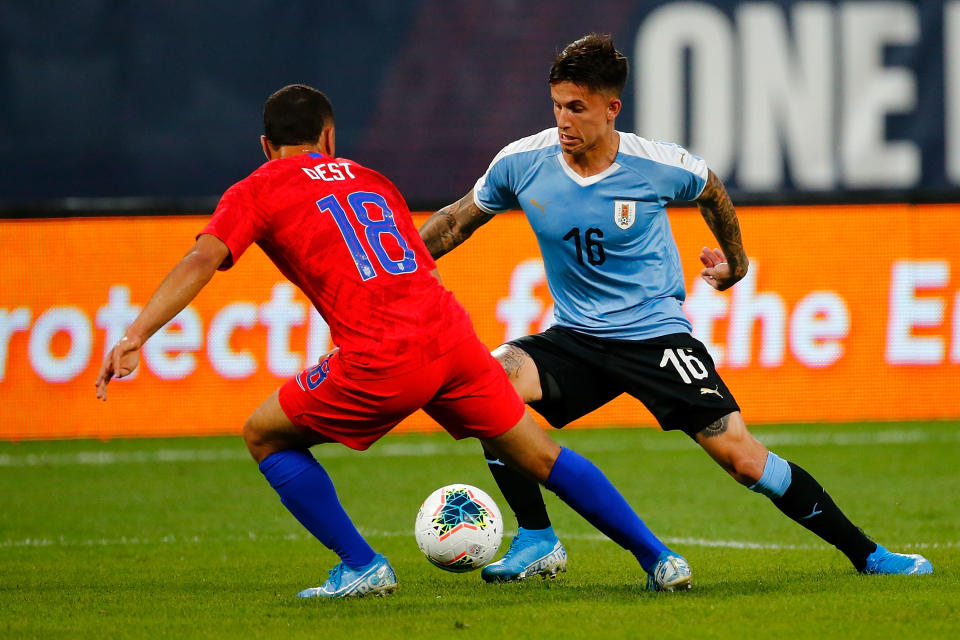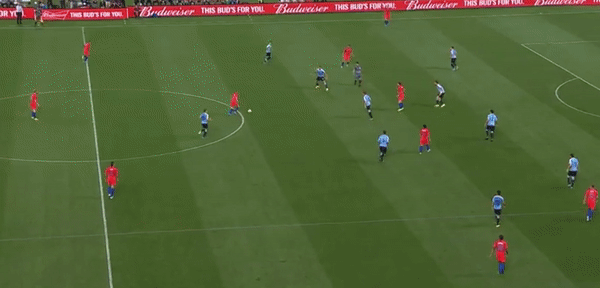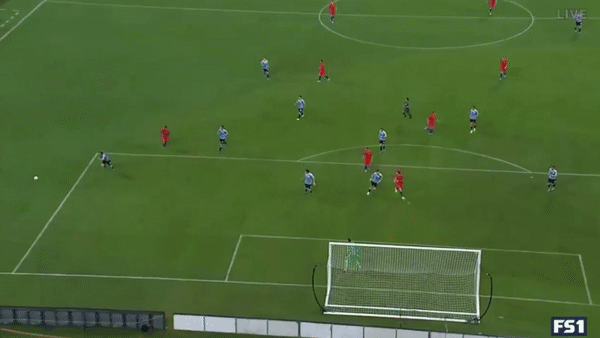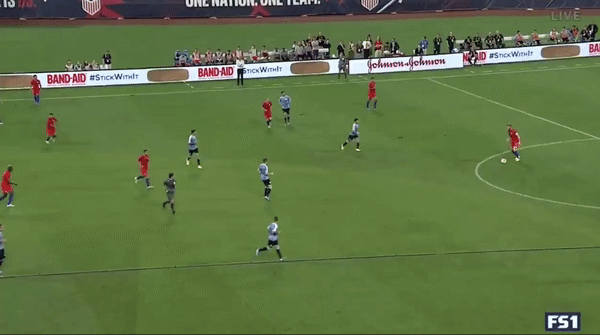USMNT 1, Uruguay 1: Takeaways from a bounceback U.S. performance

ST. LOUIS — It took an unknowing thigh and a rather fortunate chest. But after 90 minutes at Busch Stadium on Tuesday, at the end of a trying international break, the U.S. men’s national team got what it deserved.
It improved and got a just reward.
It rebounded from a Mexican beatdown, and in doing so redirected a narrative.
Specifically, the USMNT got a 1-1 draw with Uruguay in front of 20,625 in St. Louis. More importantly, it was calm and convincing. It was rational and balanced.
Tuesday was, for reasons both in and outside the Americans’ control, everything Friday hadn’t been. The Yanks matched the world’s fifth-ranked team chance for chance, pass for pass, tackle for tackle.
For much of the second half, it appeared quality would win out. A Uruguay B-plus team had more of it than a U.S. B-plus team – most noticeably in the 50th minute, when the visitors broke from infield to outfield in the blink of an eye and punished the hosts:
Uruguay strike first! 🇺🇾
It's LAFC's Brian Rodriguez who opens the scoring with his first career international goal on just his second cap! #USAvURU pic.twitter.com/SgcV1Gb962— FOX Soccer (@FOXSoccer) September 11, 2019
But the Americans kept pushing, with a combination of patience and incisiveness. And in fluky fashion – but at the end of a two-pass move emblematic of their success – they got their goal:
Hey, they all count. 🤷♂️
Tie game in St. Louis! #USAvURU pic.twitter.com/vLNlYJ0iyQ— FOX Soccer (@FOXSoccer) September 11, 2019
The U.S. was better – than it had been Friday, and than many expected it to be Tuesday – in part because Uruguay declined to press like Mexico had. Because the World Cup quarterfinalists have a stylistically driven tendency to play both up and down to their competition. They allowed the Americans to possess, to get comfortable, to dictate the game.
But the U.S. still needed to dictate it to their liking. For the most part, they did just that.
Here’s a look at how; at why Tuesday was so different than Friday; and at what we can take away from it.
Takeaways from the USMNT performance
1. Tuesday was its own beast
There’ll be a tendency to consider Tuesday in last Friday’s shadow. But there’s little use in considering one in the context of the other. Opponents’ approaches were night and day. So was the U.S. starting 11, with Christian Pulisic, Weston McKennie and others returning to Europe after the 3-0 loss to Mexico.
Psychologically, Tuesday was a strong response. But let’s analyze U.S. 1, Uruguay 1 as its own beast, rather than as half of a larger one.
2. Why Jordan Morris stayed wide (and thrived)
Jordan Morris, the USMNT’s goalscorer, was also the USMNT’s best player Tuesday night. His direct attacking was a welcome departure from Friday’s allergies to exactly that. He drove at his opposing fullback, and created the best American chance from open play with a driven left-footed cross that whizzed through the six-yard box. (Tyler Boyd botched the finish.)
HOW!? 😱😱 Morris serves up a wonderful cross to Boyd but he skips it off the ground and over the bar from close range. #USAvURU pic.twitter.com/lLuDE1WAJL
— FOX Soccer (@FOXSoccer) September 11, 2019
A big part of Morris’ success was a U.S. game plan that suited his strengths. Anticipating Uruguay’s compactness, U.S. boss Gregg Berhalter parked his wingers on the touchlines. With few opportunities to stretch the Uruguayans vertically, this ploy stretched them horizontally. And with Uruguay preferring to remain compact and deter line-breaking passes, deep-lying U.S. midfielder Jackson Yueill sprayed several long diagonals to Morris.
From there, Morris could run at an isolated defender. He could wait for left back Sergiño Dest to join him, creating an overload. Or, he could look for left-sided attacking midfielder Sebastian Lletget as a passing option inside.

All three choices, at one point or another, stimulated the U.S. in the final third.
3. Sergiño Dest, underlapping fullback
Morris’ wide position also played to Dest’s strengths. The teenage Dutch-born fullback underlapped rather than overlapped, coming inside on his right foot. He swung in dangerous crosses, but also connected with midfielders in positions not dissimilar to the one Berhalter designed for Tyler Adams at the beginning of his reign.
And Dest, though still not polished defensively, looked comfortable in the role. “It was really interesting to see him in the inside pocket, the winger wide, and him driving across the field,” Berhalter said postgame. “This is something we didn’t talk to him about. We talked to him about the interchanging positions, playing inside, but as he drives and combines, to keep getting across the field, it’s an interesting wrinkle to his game.”
4. Jackson Yueill was very good ...
... especially considering he’s a 22-year-old with one previous national team appearance to his name, who was up against a Uruguayan side featuring midfielders at Real Madrid, Juventus and Inter Milan. He didn’t boss the match, but his passing kept it moving.
Jackson Yueill's night in #USAvURU, via Opta: 49/53 passing (granted, 1 missed pass was an ugly turnover that led to a Uruguay transition), 1 shot (wide), 7 defensive actions. He's still green & not really a 6 IMO, but I want to see more of him @ int'l level. pic.twitter.com/BP4rcuoKnc
— Charles Boehm (@cboehm) September 11, 2019
The situations Tuesday’s game put him in, however, were unrecognizable compared to the ones Wil Trapp found himself in Friday. Yes, Yueill was more ambitious with his passing. But he consistently had time to pick his head up and survey the field. Trapp rarely did against Mexico. The past five days aren’t evidence that he should jump Trapp in the USMNT No. 6 pecking order.
5. What went wrong on Uruguay’s goal?
The USMNT’s most glaring defensive breakdown was a blend of individual and structural shortcomings. It was, in a way, the accepted risk of using fullbacks in attacking-third half-spaces. That being said, it could have been nipped in the bud by Christian Roldan at the edge of the penalty box.

Roldan was goal-side. He was exactly where he needed to be. He just didn’t do what he needed to do. He had two options: Stay goal-side, or commit a tactical foul. He did neither.
“We had a chance to foul; we [didn’t] do it,” Berhalter explained postgame. He later confirmed it’s the type of play on which he would’ve taught Roldan to foul. “We talk about that,” Berhalter said.
He also broke down the shortcomings in detail: “To be honest, I wasn’t happy with our defensive transition today. Part of it is personnel. There’s a big difference if you have Weston McKennie and Tyler Adams on the field [instead of] the personnel we had on. But they’re smart players. It’s just about being a little bit smarter.”
In addition to missing an opportunity to foul, he said, “the recovery wasn’t great. And then we get isolated in the penalty box. The individual defending could’ve been better. But against quality teams, you can get punished. In international soccer, there’s a huge emphasis on offensive transition. For us, it’s about getting better in that phase of the game.”
6. If Roldan was culpable, he made amends on the U.S. goal
The absurdity of Nick Lima’s “assist” and Morris’ finish will distract from the buildup that got Lima into such an advanced position in the first place. But it shouldn’t. Roldan did precisely what his role in Berhalter’s system demands of him. He checked into space, received a pinpoint ball from Tim Ream on the half-turn, and picked out Lima with eyes in the back of his head:

Had the cross and finish been cleaner, we’d be talking about this as a goal the U.S. had been building toward all night.
7. The U.S. should’ve had a penalty – and Josh Sargent would’ve taken it
The U.S. should have had a chance to go into halftime 1-0 to the good. Josh Sargent rose above Atletico Madrid center back Jose Maria Gimenez to meet a Dest cross. His possibly goal-bound header struck Gimenez’s raised arm.
The referee not only missed the call, he apparently knew it almost immediately. Sargent said postgame that the ref apologized at halftime for not awarding a penalty.
The 19-year-old striker also said that had the pen been given, he would’ve taken it.
Josh Sargent told me postgame that the ref apologized at halftime for missing the handball.
I asked him if he would’ve taken the penalty had it been called…
“Yeah. 100 percent."— Henry Bushnell (@HenryBushnell) September 11, 2019
“Yeah. A hundred percent.”
– – – – – – –
Henry Bushnell is a features writer for Yahoo Sports. Have a tip? Question? Comment? Email him at henrydbushnell@gmail.com, or follow him on Twitter @HenryBushnell, and on Facebook.
More from Yahoo Sports:

